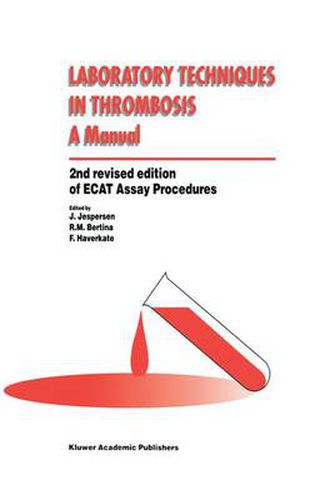Readings Newsletter
Become a Readings Member to make your shopping experience even easier.
Sign in or sign up for free!
You’re not far away from qualifying for FREE standard shipping within Australia
You’ve qualified for FREE standard shipping within Australia
The cart is loading…






This title is printed to order. This book may have been self-published. If so, we cannot guarantee the quality of the content. In the main most books will have gone through the editing process however some may not. We therefore suggest that you be aware of this before ordering this book. If in doubt check either the author or publisher’s details as we are unable to accept any returns unless they are faulty. Please contact us if you have any questions.
The first edition of this manual appeared in 1992 and was entitled ECAT Assay Procedures. It was the result of a unique cooperation between experts brought together by the European Concerted Action on Thrombosis and Disabilities (ECAT). The Concerted Action was at that time under the auspices of the Commission of the European Union. The second edition, like the first edition, deals with diagnostic tests within the field of thrombosis. However, the second edition has a broader scope because it is no longer limited by the frontiers of ECAT. Experts allover the world, in and outside ECAT, have contributed to this edition. The editors are very grateful for their contributions. The need for a new edition is obvious. Since 1992 new assays have been introduced for research, diagnosis, and therapy of thrombosis; for other assays improvements have been suggested, while a few others became redundant. The editors waived the radioimmunoassays of ~-thrombog1obulin and platelet factor 4 due to the fact that the kits required for these assays are rarely, or no longer, available. Also the PAI-1 activity assay was waived as it is liable to many inconsistencies and to large variations. A list of names and addresses of manufacturers marketing the kits and reagents has been compiled, together with a list of the recommended nomenclature of quantities in thrombosis and haemostasis, in order to facilitate the use of the updated version. These lists have been carefully compiled by Johannes J. Sidelmann, PhD, Department of Clinical Biochemistry in Esbjerg, Denmark.
$9.00 standard shipping within Australia
FREE standard shipping within Australia for orders over $100.00
Express & International shipping calculated at checkout
This title is printed to order. This book may have been self-published. If so, we cannot guarantee the quality of the content. In the main most books will have gone through the editing process however some may not. We therefore suggest that you be aware of this before ordering this book. If in doubt check either the author or publisher’s details as we are unable to accept any returns unless they are faulty. Please contact us if you have any questions.
The first edition of this manual appeared in 1992 and was entitled ECAT Assay Procedures. It was the result of a unique cooperation between experts brought together by the European Concerted Action on Thrombosis and Disabilities (ECAT). The Concerted Action was at that time under the auspices of the Commission of the European Union. The second edition, like the first edition, deals with diagnostic tests within the field of thrombosis. However, the second edition has a broader scope because it is no longer limited by the frontiers of ECAT. Experts allover the world, in and outside ECAT, have contributed to this edition. The editors are very grateful for their contributions. The need for a new edition is obvious. Since 1992 new assays have been introduced for research, diagnosis, and therapy of thrombosis; for other assays improvements have been suggested, while a few others became redundant. The editors waived the radioimmunoassays of ~-thrombog1obulin and platelet factor 4 due to the fact that the kits required for these assays are rarely, or no longer, available. Also the PAI-1 activity assay was waived as it is liable to many inconsistencies and to large variations. A list of names and addresses of manufacturers marketing the kits and reagents has been compiled, together with a list of the recommended nomenclature of quantities in thrombosis and haemostasis, in order to facilitate the use of the updated version. These lists have been carefully compiled by Johannes J. Sidelmann, PhD, Department of Clinical Biochemistry in Esbjerg, Denmark.